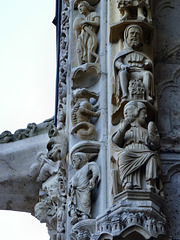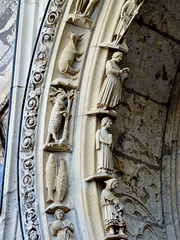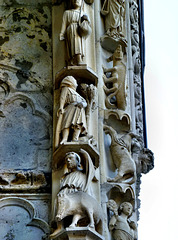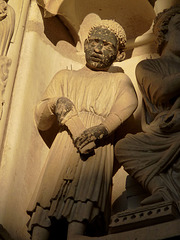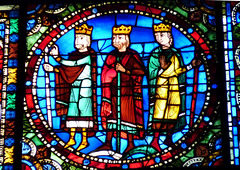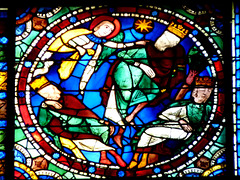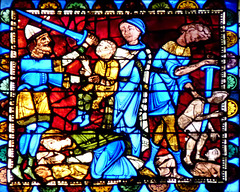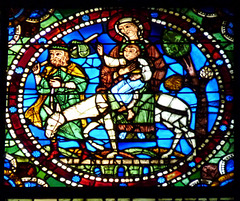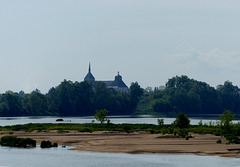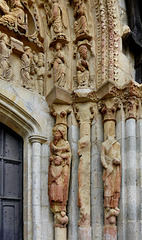
Centre
A collection of photos taken over the years. They just all have in common, that they were taken in "Centre" (since 2016 "Centre-Val de Loire") in France. Formed by the départements Cher (18), Eure-et-Loir (28)
Indre (36), Indre-et-Loire (37), Loir-et-Cher (41), Loiret (45).
Some were taken, when I crossed "Centre" following the "Via Lemovicensis" in 2006, or when I started the "Via Turonensis" i…
(read more)
Chartres - Cathédrale Notre-Dame
| |
|
|
There have been five cathedrals on this site. One was destroyed by Visigothic troops mid of the 8th century. The successive cathedral was burnt down by Vikings ("Danes") in 858. The carolingian structure that was erected within the next decades was burnt down in 962 by troops led by Richard I of Normandy (aka "Richard the Fearless", "Richard Sans-Peur").
The rebuilding started again, but whatever was completed got destroyed by a fire, caused accidently, in 1020. The erection of a Romanesque cathedral started and most of the still existing crypt dates back to that building.
In 1134, another fire damaged the town and large parts of the cathedral. The towers got repaired and rebuilt and the portal between them got created. Another blaze hit the town in June 1194. The cathedral was burnt down. Construction works started the same year. The western towers and the undamaged western portal ("Portail Royal") got integrated into the new building.
The nave was already vaulted in 1220, the transept and the stained windows were completed in 1260. On 24 October 1260, only 66 years after the start of construction, the Cathédrale Notre-Dame was consecrated in the presence of Louis IX of France (aka "Saint Louis", "le Prudhomme").
Since Charles the Bald, Louis the Pious´ son, had given the "Sancta Camisia" to the cathedral in 876. Because of this "Veil of the Virgin" Chartres developed into a very important Marian pilgrimage center in medieval times.
The south transept portals were carved between 1225 and 1260, so these works are some decades younger than the northern portals and about a century younger than the Portail Royal. While the carvings there are still in a transition from Romanesque to Gothic style, the works of the South portal are elegant Gothic.
On one of the archivolts are the zodiacs and the Labors of the Months. Here is Janus, with two faces, the personification of January. February above him is warming his hands over an open fire.
Chartres - Cathédrale Notre-Dame
| |
|
|
There have been five cathedrals on this site. One was destroyed by Visigothic troops mid of the 8th century. The successive cathedral was burnt down by Vikings ("Danes") in 858. The carolingian structure that was erected within the next decades was burnt down in 962 by troops led by Richard I of Normandy (aka "Richard the Fearless", "Richard Sans-Peur").
The rebuilding started again, but whatever was completed got destroyed by a fire, caused accidently, in 1020. The erection of a Romanesque cathedral started and most of the still existing crypt dates back to that building.
In 1134, another fire damaged the town and large parts of the cathedral. The towers got repaired and rebuilt and the portal between them got created. Another blaze hit the town in June 1194. The cathedral was burnt down. Construction works started the same year. The western towers and the undamaged western portal ("Portail Royal") got integrated into the new building.
The nave was already vaulted in 1220, the transept and the stained windows were completed in 1260. On 24 October 1260, only 66 years after the start of construction, the Cathédrale Notre-Dame was consecrated in the presence of Louis IX of France (aka "Saint Louis", "le Prudhomme").
Since Charles the Bald, Louis the Pious´ son, had given the "Sancta Camisia" to the cathedral in 876. Because of this "Veil of the Virgin" Chartres developed into a very important Marian pilgrimage center in medieval times.
The south transept portals were carved between 1225 and 1260, so these works are some decades younger than the northern portals and about a century younger than the Portail Royal. While the carvings there are still in a transition from Romanesque to Gothic style, the works of the South portal are elegant Gothic.
On one of the archivolts are the zodiacs and the Labors of the Months.
Chartres - Cathédrale Notre-Dame
| |
|
There have been five cathedrals on this site. One was destroyed by Visigothic troops mid of the 8th century. The successive cathedral was burnt down by Vikings ("Danes") in 858. The carolingian structure that was erected within the next decades was burnt down in 962 by troops led by Richard I of Normandy (aka "Richard the Fearless", "Richard Sans-Peur").
The rebuilding started again, but whatever was completed got destroyed by a fire, caused accidently, in 1020. The erection of a Romanesque cathedral started and most of the still existing crypt dates back to that building.
In 1134, another fire damaged the town and large parts of the cathedral. The towers got repaired and rebuilt and the portal between them got created. Another blaze hit the town in June 1194. The cathedral was burnt down. Construction works started the same year. The western towers and the undamaged western portal ("Portail Royal") got integrated into the new building.
The nave was already vaulted in 1220, the transept and the stained windows were completed in 1260. On 24 October 1260, only 66 years after the start of construction, the Cathédrale Notre-Dame was consecrated in the presence of Louis IX of France (aka "Saint Louis", "le Prudhomme").
Since Charles the Bald, Louis the Pious´ son, had given the "Sancta Camisia" to the cathedral in 876. Because of this "Veil of the Virgin" Chartres developed into a very important Marian pilgrimage center in medieval times.
The south transept portals were carved between 1225 and 1260, so these works are some decades younger than the northern portals and about a century younger than the Portail Royal. While the carvings there are still in a transition from Romanesque to Gothic style, the works of the South portal are elegant Gothic.
On one of the archivolts are the zodiacs and the Labors of the Months.
Chartres - Cathédrale Notre-Dame
| |
|
There have been five cathedrals on this site. One was destroyed by Visigothic troops mid of the 8th century. The successive cathedral was burnt down by Vikings ("Danes") in 858. The carolingian structure that was erected within the next decades was burnt down in 962 by troops led by Richard I of Normandy (aka "Richard the Fearless", "Richard Sans-Peur").
The rebuilding started again, but whatever was completed got destroyed by a fire, caused accidently, in 1020. The erection of a Romanesque cathedral started and most of the still existing crypt dates back to that building.
In 1134, another fire damaged the town and large parts of the cathedral. The towers got repaired and rebuilt and the portal between them got created. Another blaze hit the town in June 1194. The cathedral was burnt down. Construction works started the same year. The western towers and the undamaged western portal ("Portail Royal") got integrated into the new building.
The nave was already vaulted in 1220, the transept and the stained windows were completed in 1260. On 24 October 1260, only 66 years after the start of construction, the Cathédrale Notre-Dame was consecrated in the presence of Louis IX of France (aka "Saint Louis", "le Prudhomme").
Since Charles the Bald, Louis the Pious´ son, had given the "Sancta Camisia" to the cathedral in 876. Because of this "Veil of the Virgin" Chartres developed into a very important Marian pilgrimage center in medieval times.
The south transept portals were carved between 1225 and 1260, so these works are some decades younger than the northern portals and about a century younger than the Portail Royal. While the carvings there are still in a transition from Romanesque to Gothic style, the works of the South portal are elegant Gothic.
On one of the archivolts are the zodiacs and the Labors of the Months.
Chartres - Cathédrale Notre-Dame
| |
|
There have been five cathedrals on this site. One was destroyed by Visigothic troops mid of the 8th century. The successive cathedral was burnt down by Vikings ("Danes") in 858. The carolingian structure that was erected within the next decades was burnt down in 962 by troops led by Richard I of Normandy (aka "Richard the Fearless", "Richard Sans-Peur").
The rebuilding started again, but whatever was completed got destroyed by a fire, caused accidently, in 1020. The erection of a Romanesque cathedral started and most of the still existing crypt dates back to that building.
In 1134, another fire damaged the town and large parts of the cathedral. The towers got repaired and rebuilt and the portal between them got created. Another blaze hit the town in June 1194. The cathedral was burnt down. Construction works started the same year. The western towers and the undamaged western portal ("Portail Royal") got integrated into the new building.
The nave was already vaulted in 1220, the transept and the stained windows were completed in 1260. On 24 October 1260, only 66 years after the start of construction, the Cathédrale Notre-Dame was consecrated in the presence of Louis IX of France (aka "Saint Louis", "le Prudhomme").
Since Charles the Bald, Louis the Pious´ son, had given the "Sancta Camisia" to the cathedral in 876. Because of this "Veil of the Virgin" Chartres developed into a very important Marian pilgrimage center in medieval times.
The northern transept´s portal. There are scenes from the Old Testament - and the life of Virgin Mary. The lintel of the left portal has the Nativity and the Annunciation to the shepherds, the tympanum above the Adoration and the Dream of the Magi.
The portal was carved 1205-1210, so these works are 50 years younger than the statues of the "Portail Royal".
Chartres - Cathédrale Notre-Dame
| |
|
|
There have been five cathedrals on this site. One was destroyed by Visigothic troops mid of the 8th century. The successive cathedral was burnt down by Vikings ("Danes") in 858. The carolingian structure that was erected within the next decades was burnt down in 962 by troops led by Richard I of Normandy (aka "Richard the Fearless", "Richard Sans-Peur").
The rebuilding started again, but whatever was completed got destroyed by a fire, caused accidently, in 1020. The erection of a Romanesque cathedral started and most of the still existing crypt dates back to that building.
In 1134, another fire damaged the town and large parts of the cathedral. The towers got repaired and rebuilt and the portal between them got created. Another blaze hit the town in June 1194. The cathedral was burnt down. Construction works started the same year. The western towers and the undamaged western portal ("Portail Royal") got integrated into the new building.
The nave was already vaulted in 1220, the transept and the stained windows were completed in 1260. On 24 October 1260, only 66 years after the start of construction, the Cathédrale Notre-Dame was consecrated in the presence of Louis IX of France (aka "Saint Louis", "le Prudhomme").
Since Charles the Bald, Louis the Pious´ son, had given the "Sancta Camisia" to the cathedral in 876. Because of this "Veil of the Virgin" Chartres developed into a very important Marian pilgrimage center in medieval times.
The northern transept´s portal. There are scenes from the Old Testament - and the life of Virgin Mary. The portal was carved 1205-1210, so these works are 50 years younger than the statues of the "Portail Royal".
The Magi often are accompanied by a groom, holding the horses. Here a small servant/soldier stands next to one of the Magi (seen partly to the right). If the statue was carved about 1210, it is some decades older than the statue od Saint Maurice in Magdeburg, claimed (in Magdeburg) as the oldest picture of an ethnic African in Mid-Europe.
Chartres - Cathédrale Notre-Dame
| |
|
There have been five cathedrals on this site. One was destroyed by Visigothic troops mid of the 8th century. The successive cathedral was burnt down by Vikings ("Danes") in 858. The carolingian structure that was erected within the next decades was burnt down in 962 by troops led by Richard I of Normandy (aka "Richard the Fearless", "Richard Sans-Peur").
The rebuilding started again, but whatever was completed got destroyed by a fire, caused accidently, in 1020. The erection of a Romanesque cathedral started and most of the still existing crypt dates back to that building.
In 1134, another fire damaged the town and large parts of the cathedral. The towers got repaired and rebuilt and the portal between them got created. Another blaze hit the town in June 1194. The cathedral was burnt down. Construction works started the same year. The western towers and the undamaged western portal ("Portail Royal") got integrated into the new building.
The nave was already vaulted in 1220, the transept and the stained windows were completed in 1260. On 24 October 1260, only 66 years after the start of construction, the Cathédrale Notre-Dame was consecrated in the presence of Louis IX of France (aka "Saint Louis", "le Prudhomme").
Since Charles the Bald, Louis the Pious´ son, had given the "Sancta Camisia" to the cathedral in 876. Because of this "Veil of the Virgin" Chartres developed into a very important Marian pilgrimage center in medieval times.
Standing in the nave. A large screen blocks the view to the choir. Note the floor. This is the "Labyrinth of Chartres", one of the largest medieval labyrinths with a diameter of about 12 meters.
Here are many fascinating details,
including a nice animation:
www.mymaze.de/chartres_technisch_e.htm
Chartres - Cathédrale Notre-Dame
| |
|
|
|
There have been five cathedrals on this site. One was destroyed by Visigothic troops mid of the 8th century. The successive cathedral was burnt down by Vikings ("Danes") in 858. The carolingian structure that was erected within the next decades was burnt down in 962 by troops led by Richard I of Normandy (aka "Richard the Fearless", "Richard Sans-Peur").
The rebuilding started again, but whatever was completed got destroyed by a fire, caused accidently, in 1020. The erection of a Romanesque cathedral started and most of the still existing crypt dates back to that building.
In 1134, another fire damaged the town and large parts of the cathedral. The towers got repaired and rebuilt and the portal between them got created. Another blaze hit the town in June 1194. The cathedral was burnt down. Construction works started the same year. The western towers and the undamaged western portal ("Portail Royal") got integrated into the new building.
The nave was already vaulted in 1220, the transept and the stained windows were completed in 1260. On 24 October 1260, only 66 years after the start of construction, the Cathédrale Notre-Dame was consecrated in the presence of Louis IX of France (aka "Saint Louis", "le Prudhomme").
Since Charles the Bald, Louis the Pious´ son, had given the "Sancta Camisia" to the cathedral in 876. Because of this "Veil of the Virgin" Chartres developed into a very important Marian pilgrimage center in medieval times.
The cathedral has been fortunate in being spared the damage suffered by so many during the Wars of Religion, the Revolution and even WWII. In 1939, just before the German army invaded France, all medieval galls windows were removed, so the 176 medieval windows stayed intact.
The oldest of these windows date back to ab 1150. They had been installed already the preceding cathedral, that burnt down. The most stained glass windows seen here were created between 1215 and 1240.
Here are the Magi. There is no star visible, so they are discussing where to go.
Chartres - Cathédrale Notre-Dame
| |
|
There have been five cathedrals on this site. One was destroyed by Visigothic troops mid of the 8th century. The successive cathedral was burnt down by Vikings ("Danes") in 858. The carolingian structure that was erected within the next decades was burnt down in 962 by troops led by Richard I of Normandy (aka "Richard the Fearless", "Richard Sans-Peur").
The rebuilding started again, but whatever was completed got destroyed by a fire, caused accidently, in 1020. The erection of a Romanesque cathedral started and most of the still existing crypt dates back to that building.
In 1134, another fire damaged the town and large parts of the cathedral. The towers got repaired and rebuilt and the portal between them got created. Another blaze hit the town in June 1194. The cathedral was burnt down. Construction works started the same year. The western towers and the undamaged western portal ("Portail Royal") got integrated into the new building.
The nave was already vaulted in 1220, the transept and the stained windows were completed in 1260. On 24 October 1260, only 66 years after the start of construction, the Cathédrale Notre-Dame was consecrated in the presence of Louis IX of France (aka "Saint Louis", "le Prudhomme").
Since Charles the Bald, Louis the Pious´ son, had given the "Sancta Camisia" to the cathedral in 876. Because of this "Veil of the Virgin" Chartres developed into a very important Marian pilgrimage center in medieval times.
The cathedral has been fortunate in being spared the damage suffered by so many during the Wars of Religion, the Revolution and even WWII. In 1939, just before the German army invaded France, all medieval galls windows were removed, so the 176 medieval windows stayed intact.
The oldest of these windows date back to ab 1150. They had been installed already the preceding cathedral, that burnt down. The most stained glass windows seen here were created between 1215 and 1240.
The Dream of the Magi.
The dreaming Magi are warned by an angel about the intentions of Herod.
Matthew 2:11-12
"On coming to the house, they saw the child with his mother Mary, and they bowed down and worshipped him. Then they opened their treasures and presented him with gifts of gold and of incense and of myrrh.
And having been warned in a dream not to go back to Herod, they returned to their country by another route"
Chartres - Cathédrale Notre-Dame
| |
|
|
|
There have been five cathedrals on this site. One was destroyed by Visigothic troops mid of the 8th century. The successive cathedral was burnt down by Vikings ("Danes") in 858. The carolingian structure that was erected within the next decades was burnt down in 962 by troops led by Richard I of Normandy (aka "Richard the Fearless", "Richard Sans-Peur").
The rebuilding started again, but whatever was completed got destroyed by a fire, caused accidently, in 1020. The erection of a Romanesque cathedral started and most of the still existing crypt dates back to that building.
In 1134, another fire damaged the town and large parts of the cathedral. The towers got repaired and rebuilt and the portal between them got created. Another blaze hit the town in June 1194. The cathedral was burnt down. Construction works started the same year. The western towers and the undamaged western portal ("Portail Royal") got integrated into the new building.
The nave was already vaulted in 1220, the transept and the stained windows were completed in 1260. On 24 October 1260, only 66 years after the start of construction, the Cathédrale Notre-Dame was consecrated in the presence of Louis IX of France (aka "Saint Louis", "le Prudhomme").
Since Charles the Bald, Louis the Pious´ son, had given the "Sancta Camisia" to the cathedral in 876. Because of this "Veil of the Virgin" Chartres developed into a very important Marian pilgrimage center in medieval times.
The cathedral has been fortunate in being spared the damage suffered by so many during the Wars of Religion, the Revolution and even WWII. In 1939, just before the German army invaded France, all medieval galls windows were removed, so the 176 medieval windows stayed intact.
The oldest of these windows date back to ab 1150. They had been installed already the preceding cathedral, that burnt down. The most stained glass windows seen here were created between 1215 and 1240.
The Nativity
Mary watches the baby in the manger. Joseph has fallen asleep. The Star of Bethlehem is already over the scene, three visitors are approaching the place.. .
Chartres - Cathédrale Notre-Dame
| |
|
|
There have been five cathedrals on this site. One was destroyed by Visigothic troops mid of the 8th century. The successive cathedral was burnt down by Vikings ("Danes") in 858. The carolingian structure that was erected within the next decades was burnt down in 962 by troops led by Richard I of Normandy (aka "Richard the Fearless", "Richard Sans-Peur").
The rebuilding started again, but whatever was completed got destroyed by a fire, caused accidently, in 1020. The erection of a Romanesque cathedral started and most of the still existing crypt dates back to that building.
In 1134, another fire damaged the town and large parts of the cathedral. The towers got repaired and rebuilt and the portal between them got created. Another blaze hit the town in June 1194. The cathedral was burnt down. Construction works started the same year. The western towers and the undamaged western portal ("Portail Royal") got integrated into the new building.
The nave was already vaulted in 1220, the transept and the stained windows were completed in 1260. On 24 October 1260, only 66 years after the start of construction, the Cathédrale Notre-Dame was consecrated in the presence of Louis IX of France (aka "Saint Louis", "le Prudhomme").
Since Charles the Bald, Louis the Pious´ son, had given the "Sancta Camisia" to the cathedral in 876. Because of this "Veil of the Virgin" Chartres developed into a very important Marian pilgrimage center in medieval times.
The cathedral has been fortunate in being spared the damage suffered by so many during the Wars of Religion, the Revolution and even WWII. In 1939, just before the German army invaded France, all medieval galls windows were removed, so the 176 medieval windows stayed intact.
The oldest of these windows date back to ab 1150. They had been installed already the preceding cathedral, that burnt down. The most stained glass windows seen here were created between 1215 and 1240.
The Adoration of the Magi
Matthew 2:11
"On coming to the house, they saw the child with his mother Mary, and they bowed down and worshipped him. Then they opened their treasures and presented him with gifts of gold and of incense and of myrrh."
Chartres - Cathédrale Notre-Dame
| |
|
There have been five cathedrals on this site. One was destroyed by Visigothic troops mid of the 8th century. The successive cathedral was burnt down by Vikings ("Danes") in 858. The carolingian structure that was erected within the next decades was burnt down in 962 by troops led by Richard I of Normandy (aka "Richard the Fearless", "Richard Sans-Peur").
The rebuilding started again, but whatever was completed got destroyed by a fire, caused accidently, in 1020. The erection of a Romanesque cathedral started and most of the still existing crypt dates back to that building.
In 1134, another fire damaged the town and large parts of the cathedral. The towers got repaired and rebuilt and the portal between them got created. Another blaze hit the town in June 1194. The cathedral was burnt down. Construction works started the same year. The western towers and the undamaged western portal ("Portail Royal") got integrated into the new building.
The nave was already vaulted in 1220, the transept and the stained windows were completed in 1260. On 24 October 1260, only 66 years after the start of construction, the Cathédrale Notre-Dame was consecrated in the presence of Louis IX of France (aka "Saint Louis", "le Prudhomme").
Since Charles the Bald, Louis the Pious´ son, had given the "Sancta Camisia" to the cathedral in 876. Because of this "Veil of the Virgin" Chartres developed into a very important Marian pilgrimage center in medieval times.
The cathedral has been fortunate in being spared the damage suffered by so many during the Wars of Religion, the Revolution and even WWII. In 1939, just before the German army invaded France, all medieval galls windows were removed, so the 176 medieval windows stayed intact.
The oldest of these windows date back to ab 1150. They had been installed already the preceding cathedral, that burnt down. The most stained glass windows seen here were created between 1215 and 1240.
Massacre of the Innocents
Matthew 2:16
"When Herod realized that he had been outwitted by the Magi, he was furious, and he gave orders to kill all the boys in Bethlehem and its vicinity who were two years old and under, in accordance with the time he had learned from the Magi."
Chartres - Cathédrale Notre-Dame
| |
|
There have been five cathedrals on this site. One was destroyed by Visigothic troops mid of the 8th century. The successive cathedral was burnt down by Vikings ("Danes") in 858. The carolingian structure that was erected within the next decades was burnt down in 962 by troops led by Richard I of Normandy (aka "Richard the Fearless", "Richard Sans-Peur").
The rebuilding started again, but whatever was completed got destroyed by a fire, caused accidently, in 1020. The erection of a Romanesque cathedral started and most of the still existing crypt dates back to that building.
In 1134, another fire damaged the town and large parts of the cathedral. The towers got repaired and rebuilt and the portal between them got created. Another blaze hit the town in June 1194. The cathedral was burnt down. Construction works started the same year. The western towers and the undamaged western portal ("Portail Royal") got integrated into the new building.
The nave was already vaulted in 1220, the transept and the stained windows were completed in 1260. On 24 October 1260, only 66 years after the start of construction, the Cathédrale Notre-Dame was consecrated in the presence of Louis IX of France (aka "Saint Louis", "le Prudhomme").
Since Charles the Bald, Louis the Pious´ son, had given the "Sancta Camisia" to the cathedral in 876. Because of this "Veil of the Virgin" Chartres developed into a very important Marian pilgrimage center in medieval times.
The cathedral has been fortunate in being spared the damage suffered by so many during the Wars of Religion, the Revolution and even WWII. In 1939, just before the German army invaded France, all medieval galls windows were removed, so the 176 medieval windows stayed intact.
The oldest of these windows date back to ab 1150. They had been installed already the preceding cathedral, that burnt down. The most stained glass windows seen here were created between 1215 and 1240.
Flight into Egypt
Matthew 2:13
"When they had gone, an angel of the Lord appeared to Joseph in a dream. “Get up,” he said, “take the child and his mother and escape to Egypt. Stay there until I tell you, for Herod is going to search for the child to kill him."
Saint-Benoît-sur-Loire - Abbey
| |
|
|
The abbey at Saint-Benoît-sur-Loire (originally known as Fleury Abbey) was founded on the banks of the Loire river mid 7th century. It is one of the oldest abbeys of the Benedictine rule in France.
The story starts in 672, when some of its monks traveled to Montecassino (Italy), dug up the remains of St. Benedict of Nursia (+ 547) and his sister St. Scholastica and brought them home. After the relics had reached at Fleury Abbey it which was renamed Saint-Benoît-sur-Loire.
Saint-Benoît-sur-Loire - Abbey
| |
|
The abbey at Saint-Benoît-sur-Loire (originally known as Fleury Abbey) was founded on the banks of the Loire river mid 7th century. It is one of the oldest abbeys of the Benedictine rule in France.
The story starts in 672, when some of its monks traveled to Montecassino (Italy), dug up the remains of St. Benedict of Nursia (+ 547) and his sister St. Scholastica and brought them home. After the relics had reached at Fleury Abbey it which was renamed Saint-Benoît-sur-Loire - and due to the relics became a major place of pilgrimage.
A famous school and a scriptorium existed here in the late 10th century.
The erection of the church started around 1071. When the church was consecrated in 1108, the long nave was not completed.
The abbey thrived, but times got rougher. In 1562, the abbey was pillaged by Huguenots. The buildings were restored, but looted and destroyed again during the French Revolution. Saint-Benoît's monks left the abbey and so the history of the convent ended after more than 1100 years.
The abbey church had escaped destruction and got restored in the 19th century. In 1944, the convent was refounded the abbey buildings were rebuilt by Benedictine monks after World War II. So the history of the convent was just interrupted for about 150 years.
The massive porch tower seen here is named "Tour de Gauzlin", named for Abbot Gaucelin who commissioned it.
Saint-Benoît-sur-Loire - Abbey
| |
|
|
The abbey at Saint-Benoît-sur-Loire (originally known as Fleury Abbey) was founded on the banks of the Loire river mid 7th century. It is one of the oldest abbeys of the Benedictine rule in France.
The story starts in 672, when some of its monks traveled to Montecassino (Italy), dug up the remains of St. Benedict of Nursia (+ 547) and his sister St. Scholastica and brought them home. After the relics had reached at Fleury Abbey it which was renamed Saint-Benoît-sur-Loire - and due to the relics became a major place of pilgrimage.
A famous school and a scriptorium existed here in the late 10th century.
The erection of the church started around 1071. When the church was consecrated in 1108, the long nave was not completed.
The abbey thrived, but times got rougher. In 1562, the abbey was pillaged by Huguenots. The buildings were restored, but looted and destroyed again during the French Revolution. Saint-Benoît's monks left the abbey and so the history of the convent ended after more than 1100 years.
The abbey church had escaped destruction and got restored in the 19th century. In 1944, the convent was refounded the abbey buildings were rebuilt by Benedictine monks after World War II. So the history of the convent was just interrupted for about 150 years.
The nave got vaulted probably end of the 12th century, some decades later this side-portal was created in Gothic style. Christ, surrounded by the evangelists´ symbols, is in the center of the tympanum. In the register below, the "translatio" of St. Benedict´s relics is "told". To the left monks dig up the remains, to the right they carry the reliquary home to the abbey, inbetween they are attacked by somebody.
Fortunately the Huguenots and/or Revolutionists obviously had no ladders, when the vandalized the church, so only the statues, that were in easy reach, are very damaged.
Saint-Benoît-sur-Loire - Abbey
| |
|
|
The abbey at Saint-Benoît-sur-Loire (originally known as Fleury Abbey) was founded on the banks of the Loire river mid 7th century. It is one of the oldest abbeys of the Benedictine rule in France.
The story starts in 672, when some of its monks traveled to Montecassino (Italy), dug up the remains of St. Benedict of Nursia (+ 547) and his sister St. Scholastica and brought them home. After the relics had reached at Fleury Abbey it which was renamed Saint-Benoît-sur-Loire - and due to the relics became a major place of pilgrimage.
A famous school and a scriptorium existed here in the late 10th century.
The erection of the church started around 1071. When the church was consecrated in 1108, the long nave was not completed.
The abbey thrived, but times got rougher. In 1562, the abbey was pillaged by Huguenots. The buildings were restored, but looted and destroyed again during the French Revolution. Saint-Benoît's monks left the abbey and so the history of the convent ended after more than 1100 years.
The abbey church had escaped destruction and got restored in the 19th century. In 1944, the convent was refounded the abbey buildings were rebuilt by Benedictine monks after World War II. So the history of the convent was just interrupted for about 150 years.
The nave got vaulted probably end of the 12th century, some decades later a side-portal was created in Gothic style. On the lintel the "translatio" of St. Benedict´s relics is "told". Seen here are the returning monks, carrying the reliquary to the abbey.
Fortunately the Huguenots and/or Revolutionists obviously had no ladders, when the vandalized the church, so only the jamb statues, that were in easy reach, are very damaged.
Saint-Benoît-sur-Loire - Abbey
| |
|
|
The abbey at Saint-Benoît-sur-Loire (originally known as Fleury Abbey) was founded on the banks of the Loire river mid 7th century. It is one of the oldest abbeys of the Benedictine rule in France.
The story starts in 672, when some of its monks traveled to Montecassino (Italy), dug up the remains of St. Benedict of Nursia (+ 547) and his sister St. Scholastica and brought them home. After the relics had reached at Fleury Abbey it which was renamed Saint-Benoît-sur-Loire - and due to the relics became a major place of pilgrimage.
A famous school and a scriptorium existed here in the late 10th century.
The erection of the church started around 1071. When the church was consecrated in 1108, the long nave was not completed.
The abbey thrived, but times got rougher. In 1562, the abbey was pillaged by Huguenots. The buildings were restored, but looted and destroyed again during the French Revolution. Saint-Benoît's monks left the abbey and so the history of the convent ended after more than 1100 years.
The abbey church had escaped destruction and got restored in the 19th century. In 1944, the convent was refounded the abbey buildings were rebuilt by Benedictine monks after World War II. So the history of the convent was just interrupted for about 150 years.
The church, that stands today, was not the first church here. When it was erected, they abbey existed already longer than 400 years. I have the impression, that some spolia from the older structure were "reused" in the left walls.
The carvings differ clearly in style. Here is a large relief, depicting the death of Protomartyr Saint Stephen, the first martyr of Christianity.
Acts of Apostles 7.57-60
"All the members of the council shouted out and stopped their ears with their hands; then they made a concerted rush at him, thrust him out of the city and stoned him. The witnesses put down their clothes at the feet of a young man called Saul. As they were stoning him, Stephen said in invocation, "Lord Jesus, receive my spirit." Then he knelt down and said aloud, "Lord, do not hold this sin against them." And with these words he fell asleep."
Jump to top
RSS feed- Latest items - Subscribe to the latest items added to this album
- ipernity © 2007-2024
- Help & Contact
|
Club news
|
About ipernity
|
History |
ipernity Club & Prices |
Guide of good conduct
Donate | Group guidelines | Privacy policy | Terms of use | Statutes | In memoria -
Facebook
Twitter

